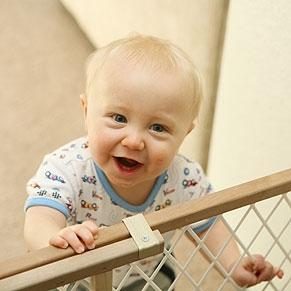
The little explorers
Kids like to explore their surroundings. Keep your little ones safe around the house with these precautions.
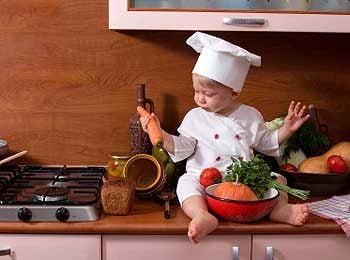
Kitchen
The golden rule here is simple; do not leave young children alone in the kitchen. Equip cabinets that contain cleaning products or sharp objects with childproof safety latches. They are easy to install and are not expensive. In addition to this, consider the following:
- Keep small appliances at the back of counters, and electric cords well out of reach of curious fingers. It’s a good idea to unplug kitchen appliances when you’re not using them. This not only prevents youngsters from operating them, but also avoids potential shocks should one of them pull a connected appliance into a water-filled sink.
- Store plastic storage bags out of children’s reach. Always tie knots in used plastic bags before you recycle or throw them away. This will keep kids from playing with them and possibly suffering accidental suffocation.
- Place sharp knives on the top rack of the dishwasher or in the silverware basket with blades down to reduce the risk of injury to a curious child.
- Fill the detergent dispenser cup of your automatic dishwasher only when you’re ready to run it.
- Keep pet food and water bowls away from toddlers and infants.
- Use a covered trash basket, and install a safety latch on the cabinet where it is kept. This will prevent little ones and pets from foraging in trash that may contain broken glass, splintered bones, or poisonous substances.
- Teach older kids to use appliances safely and with supervision, including the microwave oven, if you use one.
- Place food and drinks near the centre of a table or at the back of a counter. And avoid using tablecloths except for special occasions: They are easily pulled off by toddlers and pets.
- Exercise extreme caution around the stove when children are present. Cook on the back burners, and turn the pot handles back out of small children’s sight line and reach. And use safety covers for stove knobs if they are within reach of a young child.
- It’s also a good idea to always store cookies and other tempting foods away from the stove, and to keep the step stool far from the cooking area.
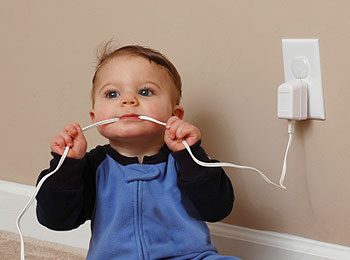
Living Room and Bedrooms
The following safety measures may be a bit drastic if your home is visited only infrequently by a child, but they are recommended if you have children or grandchildren around regularly.
- Check furniture placement to be sure everything is secure. TVs are a particular hazard as they are heavy and can tip over easily, especially if on a high shelf. Large wall mirrors and artwork should also be secured.
- Keep small decorative items out of reach. They can present a choking danger. Put sharp objects away, too.
- Some recliners can cause serious injuries by closing on a child’s fingers, arm, or head. Choose a recliner model that doesn’t snap shut hard, and keep children away from its scissors-like mechanisms when operating.
- Likewise, remove any chest or trunk that has a heavy, hinged lid that can fall shut, or make sure the lid is well fastened.
- Secure electrical cords, especially in traffic zones (but avoid placing them under the carpet, as this is can be a fire hazard).
- Insert plastic safety caps into all open electrical receptacles, and teach children to stay away from electrical cords and outlets.
- Install screens and safety rails by fireplaces and on radiators to prevent burns. Keep kids away from wood stoves and space heaters, or avoid using them while small children are present.
- Keep toddler’s toys on reachable shelves, or else out of sight. Make sure a toy chest has a safety lid. Teach kids not to climb inside furnishings.
- Use protectors to cover sharp corners on tables and other furniture that children might bump into.
- Falls are a leading cause of injuries in children. Don’t allow kids unsupervised access to balconies, porches, or windows. And pull any climbable furniture away from windows.
- A baby’s crib should meet safety regulations. Slats should be no more than 6 cm (2-3/8 in.) apart so a newborn’s head can’t get wedged between, and the mattress should fit snugly. Stop using a crib when the child can climb over its rails.
- Secure drapery cords out of the reach of children. Don’t place a crib or young child’s bed within reach of these or within reach of electrical cords, outlets, lamps, wall mirrors, or pictures.
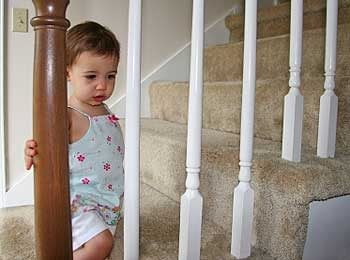
Stairs
Falls on stairs are a leading cause of injuries in children, but a few precautions can reduce the dangers significantly.
- Use safety gates to keep small children away from stairs. Use only gates that meet current safety standards; older accordion-style gates can trap a child’s arms, legs, or head.
- Balusters should be close together to keep children and pets from falling through or getting their heads stuck. If balusters are more than 10 cm (4 in.) apart, install a barrier while your kids are young.
- Be sure the railing is sturdy, and discourage kids from sliding down the banister even when supervised. Otherwise it is pretty sure they will then try it on their own, when you are not around.
- Wooden stairs and socks or slippers have always been a slippery combination. Carpeted stairs are safer, especially if they have no raised metal edges for the child to trip over. And always keep stairs and landings free of clutter.
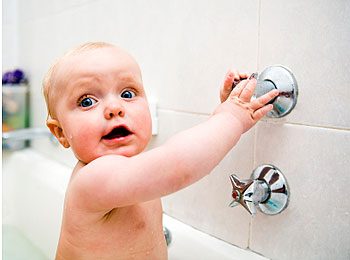
Bathroom
Never leave a baby or young child alone in the tub. A toddler can drown in an inch of water. And don’t leave water in an unattended tub. Cut down on other risks by following these suggestions:
- Purchase a soft cover for the bathtub spout to protect kids from painful collisions with the tub spout.
- Keep hair dryers and other electrical appliances unplugged, out of reach, and away from sinks and bathtubs to prevent burns and accidental electrocution.
- Use tub mats to prevent slipping. Non-slip strips and appliqués are often too widely spaced to protect children.
- Adjust water heater temperature to between 49° and 54°C (120° and 130°F), which is hot enough for an adult shower, but not so hot that it could scald a child. Make it a habit to turn faucets off tightly so they’re not easy for children to turn on.
- Keep cologne, makeup, bubble bath, and other hazardous products in a closed cabinet, out of reach and sight.